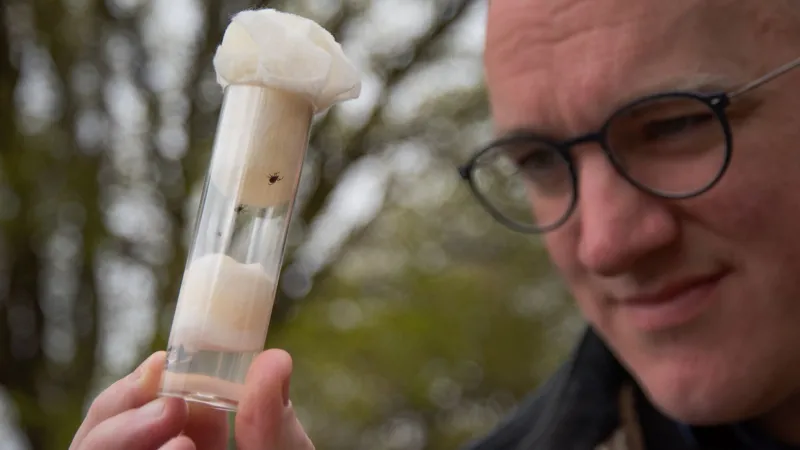Tick attack: BBC hunts for tiny bloodsuckers as diseases rise
Am I the hunter or the hunted?

It's the question running through my mind as I stroll through the long grass and bracken.
I’ve come to the park looking for blood-sucking ticks - to find out how common they are, why new species and new tick-borne diseases are coming to the UK and to discover how worried we should be.
But I’m keenly aware I’m also dinner for hungry parasites and that the blood pulsing through my legs is a gourmet meal for a tick that hasn’t tasted warm blood since before winter. So, hunter or hunted?
"I think you're probably a bit of both," says Prof Sally Cutler, medical microbiologist at the University of East London, who is going to teach me how to find the tiny parasites.
Tick-hunting gear is surprisingly rustic. Prof Cutler hands me a blanket with a wooden pole sewn into the top and attached to a piece of string.
The species we're looking for, the castor bean tick or Ixodes ricinus, climbs to the top of a blade of grass or other vegetation where it plays the waiting game.
We pull a blanket along the ground to find the ticks
The blanket deceives the ticks into believing a furry animal has just walked by so they jump on board.
We've gone only 30 paces into our walk in Richmond Park, south-west London, before Prof Cutler says it's time to flip over the blanket.
There, in the corner, are a trio of ticks.
I’m shocked at how little effort it took to find them and by how small they are. You could fit dozens of them on a fingernail.
These are nymphs, the second stage in the tick’s life cycle.
Ticks hatch as six-legged larvae and gorge themselves so much on their first blood-meal they sprout an extra pair of legs (and I thought I was stuffed after a Christmas dinner), becoming nymphs.
The nymphs we found are already able to spread disease, and because they are so small they are easy to miss. In the dense thicket of my hairy legs, I doubt I would notice if one had latched on.
"We can still see where we parked the car, but it just shows that even in verges, in your back garden, all kinds of areas, you could have ticks,” says Prof Cutler.
"Here we are in the middle of London, but ticks are going to be pretty well anywhere in the UK," she says.
They are most commonly found in grassy and wooden areas.
Prof Cutler bottles up the nymphs and we go hunting again.
We spend half an hour floating the blanket across the vegetation adding dozens of ticks to our collection, including nymphs and the more elusive adult males and females.
I'd anticipated this hunt being a fruitless exercise, not that we'd be leaving with vial after vial after vial of ticks.
They are remarkably easy to find here.
Milder winters caused by climate change is thought to be making tick season start earlier and last longer as well as making it possible for new species to survive in the UK.
So are ticks something we are all going to have to get used to?
"The numbers do appear to be increasing," Prof Cutler says.
"We’re seeing different types of ticks that have been establishing in the UK so it all points towards that."
Dangerous diseases
If all ticks did was bite they would just be a nuisance. But like mosquitoes they spread disease when they plunge their mouths into our skin to drink blood.
The most well-known is Lyme disease.
About 4% of ticks carry the bacteria that cause the infection, which can trigger years of aches and fatigue.
Ticks can also spread the Babesia parasite, which causes disease by infecting red blood cells.
A virus that causes tick-borne encephalitis and potentially deadly brain swelling has become established in the UK too.
Meanwhile, new species such as the European meadow tick (Dermacentor reticulatus) has made its home in the UK and carries a disease that has led to the deaths of pet dogs.
The ticks bottled up ready to be inspected back at the laboratory
Realising you have an infection from a tick can be hard.
"It can take weeks to months before it starts to develop and you might have forgotten that you'd been bitten by a tick," says Prof Cutler.
And many diseases have vague initial symptoms like aching joints, headaches or fatigue.
The exception is Lyme disease which can have a distinctive rash shaped like a bullseye.
Prof Culter says the "scariest disease" on the horizon is Crimean Congo haemorrhagic fever, which kills up to 40% of people infected.
"It was localised around the Mediterranean Basin, but it's now spreading," she says.
The disease is not in the UK, but the species of ticks that transmit the fever have been spotted on rare occasions.
At her laboratory, Prof Cutler shows me one of the female ticks we caught under the microscope.
To me it looks like eight legs attacked to a chainsaw of a mouth.
BBC/Emma Lynch View of tick's mouth as seen through a microscopeBBC/Emma Lynch
A view of the tick's mouthparts down the microscope
Once the tick has plunged its whole head into the skin it cements itself in place, Prof Cutler tells me.
It is why you shouldn't just yank a tick out of your skin. This risks squeezing the body or leaving the head in the wound which both increase the risk of catching a disease.
It is recommended to:
Use a tick removal device or fine-toothed tweezers to gently grip the tick as close to the skin as possible.
Pull steadily away from the skin without crushing the tick.
Wash your skin with water and soap afterwards.
Apply an antiseptic cream to the skin around the bite.
Having said all that, Prof Cutler then offers to put a tick on my hand.
She wants to show me how light they are, which makes it easy for them to go unnoticed even as they crawl on your skin.
"It should be safe because it takes several hours for them to actually bite," she attempts to reassure me.
As it lumbers around my hand (they move with neither speed nor grace) I'm left wondering how much we should worry about ticks and whether I should ever wear shorts again?
"I think worried is probably the wrong word, I would say concerned," says Prof Cutler.
"Enjoy the countryside, but we ought to also have that awareness that there are ticks out there and that ticks can transmit infectious diseases."
-bbc







